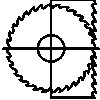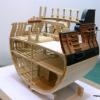-
Posts
129 -
Joined
-
Last visited
Reputation Activity
-
 lehmann got a reaction from Archi in Help reading plan
lehmann got a reaction from Archi in Help reading plan
I agree with Don Robinson - a steep pipe, probably through the water way. The feature you show on the deck is aft of the windlass, which certainly won't work.
I know the replica of the Nonsuch has a windlass, so I tried to find a photo. The best I found was at https://photo-bytes.com/308-down-below. Unfortunately, the entrance of the hawser on deck is not shown. There is also a picture below-decks in the fo'c's'le, but no evidence of a pipe. Keep in mind that the Nonsuch was almost 200 years earlier than your ship.
-
 lehmann got a reaction from reklein in Calipers or height gauge
lehmann got a reaction from reklein in Calipers or height gauge
I was planning to make a set of wooded calipers/height gauge following Ed Tosti's design. However, I was at a local tool store that had metal squares on sale for $6 and I got the idea to use two of these to make the calipers. The result is shown in the attached pictures. Very solid, perfectly square (after a little tweaking), it has a built-in ruler, and I got an second ruler out of it.
While I did file a sharp point to the end of the caliper, the metal is pretty soft (aluminum or zinc). If I need to do serious scribing, I'll attach a small knife.
-
 lehmann got a reaction from Mike Y in Calipers or height gauge
lehmann got a reaction from Mike Y in Calipers or height gauge
I was planning to make a set of wooded calipers/height gauge following Ed Tosti's design. However, I was at a local tool store that had metal squares on sale for $6 and I got the idea to use two of these to make the calipers. The result is shown in the attached pictures. Very solid, perfectly square (after a little tweaking), it has a built-in ruler, and I got an second ruler out of it.
While I did file a sharp point to the end of the caliper, the metal is pretty soft (aluminum or zinc). If I need to do serious scribing, I'll attach a small knife.
-
 lehmann got a reaction from thibaultron in Calipers or height gauge
lehmann got a reaction from thibaultron in Calipers or height gauge
I was planning to make a set of wooded calipers/height gauge following Ed Tosti's design. However, I was at a local tool store that had metal squares on sale for $6 and I got the idea to use two of these to make the calipers. The result is shown in the attached pictures. Very solid, perfectly square (after a little tweaking), it has a built-in ruler, and I got an second ruler out of it.
While I did file a sharp point to the end of the caliper, the metal is pretty soft (aluminum or zinc). If I need to do serious scribing, I'll attach a small knife.
-
 lehmann got a reaction from mtaylor in Calipers or height gauge
lehmann got a reaction from mtaylor in Calipers or height gauge
I was planning to make a set of wooded calipers/height gauge following Ed Tosti's design. However, I was at a local tool store that had metal squares on sale for $6 and I got the idea to use two of these to make the calipers. The result is shown in the attached pictures. Very solid, perfectly square (after a little tweaking), it has a built-in ruler, and I got an second ruler out of it.
While I did file a sharp point to the end of the caliper, the metal is pretty soft (aluminum or zinc). If I need to do serious scribing, I'll attach a small knife.
-
 lehmann got a reaction from Maury S in Calipers or height gauge
lehmann got a reaction from Maury S in Calipers or height gauge
I was planning to make a set of wooded calipers/height gauge following Ed Tosti's design. However, I was at a local tool store that had metal squares on sale for $6 and I got the idea to use two of these to make the calipers. The result is shown in the attached pictures. Very solid, perfectly square (after a little tweaking), it has a built-in ruler, and I got an second ruler out of it.
While I did file a sharp point to the end of the caliper, the metal is pretty soft (aluminum or zinc). If I need to do serious scribing, I'll attach a small knife.
-
 lehmann got a reaction from BANYAN in Calipers or height gauge
lehmann got a reaction from BANYAN in Calipers or height gauge
I was planning to make a set of wooded calipers/height gauge following Ed Tosti's design. However, I was at a local tool store that had metal squares on sale for $6 and I got the idea to use two of these to make the calipers. The result is shown in the attached pictures. Very solid, perfectly square (after a little tweaking), it has a built-in ruler, and I got an second ruler out of it.
While I did file a sharp point to the end of the caliper, the metal is pretty soft (aluminum or zinc). If I need to do serious scribing, I'll attach a small knife.
-
 lehmann got a reaction from RichardG in Calipers or height gauge
lehmann got a reaction from RichardG in Calipers or height gauge
I was planning to make a set of wooded calipers/height gauge following Ed Tosti's design. However, I was at a local tool store that had metal squares on sale for $6 and I got the idea to use two of these to make the calipers. The result is shown in the attached pictures. Very solid, perfectly square (after a little tweaking), it has a built-in ruler, and I got an second ruler out of it.
While I did file a sharp point to the end of the caliper, the metal is pretty soft (aluminum or zinc). If I need to do serious scribing, I'll attach a small knife.
-
 lehmann got a reaction from Canute in Calipers or height gauge
lehmann got a reaction from Canute in Calipers or height gauge
I was planning to make a set of wooded calipers/height gauge following Ed Tosti's design. However, I was at a local tool store that had metal squares on sale for $6 and I got the idea to use two of these to make the calipers. The result is shown in the attached pictures. Very solid, perfectly square (after a little tweaking), it has a built-in ruler, and I got an second ruler out of it.
While I did file a sharp point to the end of the caliper, the metal is pretty soft (aluminum or zinc). If I need to do serious scribing, I'll attach a small knife.
-
 lehmann got a reaction from Julie Mo in a shopbuilt milling jig for Dremel rotary tool
lehmann got a reaction from Julie Mo in a shopbuilt milling jig for Dremel rotary tool
Overall, a good design. I was just think of something like this for semi-automating block production.
One simple improvement would to add adjustable gibs on the dovetails slides. With wood construction you can expect to see tightness of the slides change with the relative humidity. I see that the rails of the dovetails are held down with counter-bored screws, so there is an ability to adjust the tightness, but this also creates a chance for them to slip. I would insert a 1/8" hardwood gib, held in and adjusted by two 1/4" bolts. This should eliminate a lot of frustration with chatter and unpredictable sizes.
Second point when building: make sure the axis of the rotary tool is parallel in both planes to the Z axis slide. If this isn't done, then you'll be breaking drill bits, especially for the fine sizes. If the case of the rotary tool is round and concentric, then the method described in the article will be fine, but expect to do a little shimming to get if right on.
As others have mentioned, other than the left hand threaded rod and nuts, there is nothing exotic here. You could use right hand threads, but if you're used to full sized milling machines, like I am, you'll end up going in the wrong direction and wrecking parts. If you're not used to full size machines, you have no muscle memory to over-ride and you'll be fine.
What's needed next is the lathe, so you can make nice hand wheels...
-
 lehmann got a reaction from mtaylor in Sheer and camber
lehmann got a reaction from mtaylor in Sheer and camber
Don,
I think the bigger problem is what you had in your first post - how to bend plywood in two directions. Plywood only likes to bend in one direction. I think one-piece decks only work for short decks, not where the deck runs the entire length. I see two options:
Rip the false deck in to narrow strips, perhaps about 10 mm wide. You'll lose some material, ending up with gaps and there will be a bit of a kink at the joints, but that can be sanded down and covered by the final planking. You could also add filler strips. This has the added benefit that you don't have to fit the whole deck at once, and you can get some clamps under the deck beams. With a little bit of planning, you can make the first strip near the rail fit between the "ribs". Make some kerf-cuts on the underside of the false deck. This may give it enough flexibility to bend in two directions. However, I don't have much hope for this idea. Option 1, seems best to me: it will allow you to fair the height of the deck beams as you go, if needed.
-
 lehmann got a reaction from Seventynet in Sheer and camber
lehmann got a reaction from Seventynet in Sheer and camber
Don,
I think the bigger problem is what you had in your first post - how to bend plywood in two directions. Plywood only likes to bend in one direction. I think one-piece decks only work for short decks, not where the deck runs the entire length. I see two options:
Rip the false deck in to narrow strips, perhaps about 10 mm wide. You'll lose some material, ending up with gaps and there will be a bit of a kink at the joints, but that can be sanded down and covered by the final planking. You could also add filler strips. This has the added benefit that you don't have to fit the whole deck at once, and you can get some clamps under the deck beams. With a little bit of planning, you can make the first strip near the rail fit between the "ribs". Make some kerf-cuts on the underside of the false deck. This may give it enough flexibility to bend in two directions. However, I don't have much hope for this idea. Option 1, seems best to me: it will allow you to fair the height of the deck beams as you go, if needed.
-
 lehmann got a reaction from Rat-Fink-A-Booboo in Sheer and camber
lehmann got a reaction from Rat-Fink-A-Booboo in Sheer and camber
Don,
I think the bigger problem is what you had in your first post - how to bend plywood in two directions. Plywood only likes to bend in one direction. I think one-piece decks only work for short decks, not where the deck runs the entire length. I see two options:
Rip the false deck in to narrow strips, perhaps about 10 mm wide. You'll lose some material, ending up with gaps and there will be a bit of a kink at the joints, but that can be sanded down and covered by the final planking. You could also add filler strips. This has the added benefit that you don't have to fit the whole deck at once, and you can get some clamps under the deck beams. With a little bit of planning, you can make the first strip near the rail fit between the "ribs". Make some kerf-cuts on the underside of the false deck. This may give it enough flexibility to bend in two directions. However, I don't have much hope for this idea. Option 1, seems best to me: it will allow you to fair the height of the deck beams as you go, if needed.
-
 lehmann got a reaction from Chuck Seiler in Sheer and camber
lehmann got a reaction from Chuck Seiler in Sheer and camber
Don,
I think the bigger problem is what you had in your first post - how to bend plywood in two directions. Plywood only likes to bend in one direction. I think one-piece decks only work for short decks, not where the deck runs the entire length. I see two options:
Rip the false deck in to narrow strips, perhaps about 10 mm wide. You'll lose some material, ending up with gaps and there will be a bit of a kink at the joints, but that can be sanded down and covered by the final planking. You could also add filler strips. This has the added benefit that you don't have to fit the whole deck at once, and you can get some clamps under the deck beams. With a little bit of planning, you can make the first strip near the rail fit between the "ribs". Make some kerf-cuts on the underside of the false deck. This may give it enough flexibility to bend in two directions. However, I don't have much hope for this idea. Option 1, seems best to me: it will allow you to fair the height of the deck beams as you go, if needed.
-
 lehmann got a reaction from BETAQDAVE in thin wooden mast reinforcing
lehmann got a reaction from BETAQDAVE in thin wooden mast reinforcing
Not that I want to spread alarm about breaking spars, but what you are worried about actually happened to the USS Constitution in 1997.
https://ussconstitutionmuseum.org/2017/04/20/springtime-for-uss-constitution/.
The moral of the story is don't expose your model to 70 mph winds and 2 ft of snow (or the equivalent in whatever scale you're working at)!
On a more practical tone, going to a strong hardwood, such as maple, would be my first choice. However, straight grain is also a larger factor, so best to split the raw material for the rough blank rather than saw it. Any wood that is going to be subject to bending loads, such as chair backs, bows, etc, are made from split stock.
-
 lehmann got a reaction from mtaylor in Framing Math
lehmann got a reaction from mtaylor in Framing Math
For examples of computer generated hulls, have a look at the CAD & 3D forum. The most recent post shows exactly what you're thinking about.
Pandora 3D Even with good modelling software, this is a difficult and time consuming task.
Further to Druxey's post, the starting point for ship builders was to lay out the frames was to use parts of circles. However, a planked hull is not composed of sections of cylinders or cones unless hard chines are used, as in plywood boats. I suspect that once the frames were up, the process of fairing the frames for planking involved heavy use of the adze and broad axe.
-
 lehmann got a reaction from mtaylor in thin wooden mast reinforcing
lehmann got a reaction from mtaylor in thin wooden mast reinforcing
Not that I want to spread alarm about breaking spars, but what you are worried about actually happened to the USS Constitution in 1997.
https://ussconstitutionmuseum.org/2017/04/20/springtime-for-uss-constitution/.
The moral of the story is don't expose your model to 70 mph winds and 2 ft of snow (or the equivalent in whatever scale you're working at)!
On a more practical tone, going to a strong hardwood, such as maple, would be my first choice. However, straight grain is also a larger factor, so best to split the raw material for the rough blank rather than saw it. Any wood that is going to be subject to bending loads, such as chair backs, bows, etc, are made from split stock.
-
 lehmann got a reaction from WackoWolf in Framing Math
lehmann got a reaction from WackoWolf in Framing Math
For examples of computer generated hulls, have a look at the CAD & 3D forum. The most recent post shows exactly what you're thinking about.
Pandora 3D Even with good modelling software, this is a difficult and time consuming task.
Further to Druxey's post, the starting point for ship builders was to lay out the frames was to use parts of circles. However, a planked hull is not composed of sections of cylinders or cones unless hard chines are used, as in plywood boats. I suspect that once the frames were up, the process of fairing the frames for planking involved heavy use of the adze and broad axe.
-
 lehmann got a reaction from druxey in Framing Math
lehmann got a reaction from druxey in Framing Math
For examples of computer generated hulls, have a look at the CAD & 3D forum. The most recent post shows exactly what you're thinking about.
Pandora 3D Even with good modelling software, this is a difficult and time consuming task.
Further to Druxey's post, the starting point for ship builders was to lay out the frames was to use parts of circles. However, a planked hull is not composed of sections of cylinders or cones unless hard chines are used, as in plywood boats. I suspect that once the frames were up, the process of fairing the frames for planking involved heavy use of the adze and broad axe.
-
 lehmann got a reaction from jud in thin wooden mast reinforcing
lehmann got a reaction from jud in thin wooden mast reinforcing
Not that I want to spread alarm about breaking spars, but what you are worried about actually happened to the USS Constitution in 1997.
https://ussconstitutionmuseum.org/2017/04/20/springtime-for-uss-constitution/.
The moral of the story is don't expose your model to 70 mph winds and 2 ft of snow (or the equivalent in whatever scale you're working at)!
On a more practical tone, going to a strong hardwood, such as maple, would be my first choice. However, straight grain is also a larger factor, so best to split the raw material for the rough blank rather than saw it. Any wood that is going to be subject to bending loads, such as chair backs, bows, etc, are made from split stock.
-
 lehmann got a reaction from thibaultron in thin wooden mast reinforcing
lehmann got a reaction from thibaultron in thin wooden mast reinforcing
Not that I want to spread alarm about breaking spars, but what you are worried about actually happened to the USS Constitution in 1997.
https://ussconstitutionmuseum.org/2017/04/20/springtime-for-uss-constitution/.
The moral of the story is don't expose your model to 70 mph winds and 2 ft of snow (or the equivalent in whatever scale you're working at)!
On a more practical tone, going to a strong hardwood, such as maple, would be my first choice. However, straight grain is also a larger factor, so best to split the raw material for the rough blank rather than saw it. Any wood that is going to be subject to bending loads, such as chair backs, bows, etc, are made from split stock.
-
 lehmann got a reaction from mtaylor in a shopbuilt milling jig for Dremel rotary tool
lehmann got a reaction from mtaylor in a shopbuilt milling jig for Dremel rotary tool
Overall, a good design. I was just think of something like this for semi-automating block production.
One simple improvement would to add adjustable gibs on the dovetails slides. With wood construction you can expect to see tightness of the slides change with the relative humidity. I see that the rails of the dovetails are held down with counter-bored screws, so there is an ability to adjust the tightness, but this also creates a chance for them to slip. I would insert a 1/8" hardwood gib, held in and adjusted by two 1/4" bolts. This should eliminate a lot of frustration with chatter and unpredictable sizes.
Second point when building: make sure the axis of the rotary tool is parallel in both planes to the Z axis slide. If this isn't done, then you'll be breaking drill bits, especially for the fine sizes. If the case of the rotary tool is round and concentric, then the method described in the article will be fine, but expect to do a little shimming to get if right on.
As others have mentioned, other than the left hand threaded rod and nuts, there is nothing exotic here. You could use right hand threads, but if you're used to full sized milling machines, like I am, you'll end up going in the wrong direction and wrecking parts. If you're not used to full size machines, you have no muscle memory to over-ride and you'll be fine.
What's needed next is the lathe, so you can make nice hand wheels...
-
 lehmann got a reaction from Canute in a shopbuilt milling jig for Dremel rotary tool
lehmann got a reaction from Canute in a shopbuilt milling jig for Dremel rotary tool
Overall, a good design. I was just think of something like this for semi-automating block production.
One simple improvement would to add adjustable gibs on the dovetails slides. With wood construction you can expect to see tightness of the slides change with the relative humidity. I see that the rails of the dovetails are held down with counter-bored screws, so there is an ability to adjust the tightness, but this also creates a chance for them to slip. I would insert a 1/8" hardwood gib, held in and adjusted by two 1/4" bolts. This should eliminate a lot of frustration with chatter and unpredictable sizes.
Second point when building: make sure the axis of the rotary tool is parallel in both planes to the Z axis slide. If this isn't done, then you'll be breaking drill bits, especially for the fine sizes. If the case of the rotary tool is round and concentric, then the method described in the article will be fine, but expect to do a little shimming to get if right on.
As others have mentioned, other than the left hand threaded rod and nuts, there is nothing exotic here. You could use right hand threads, but if you're used to full sized milling machines, like I am, you'll end up going in the wrong direction and wrecking parts. If you're not used to full size machines, you have no muscle memory to over-ride and you'll be fine.
What's needed next is the lathe, so you can make nice hand wheels...
-
 lehmann got a reaction from thibaultron in a shopbuilt milling jig for Dremel rotary tool
lehmann got a reaction from thibaultron in a shopbuilt milling jig for Dremel rotary tool
Overall, a good design. I was just think of something like this for semi-automating block production.
One simple improvement would to add adjustable gibs on the dovetails slides. With wood construction you can expect to see tightness of the slides change with the relative humidity. I see that the rails of the dovetails are held down with counter-bored screws, so there is an ability to adjust the tightness, but this also creates a chance for them to slip. I would insert a 1/8" hardwood gib, held in and adjusted by two 1/4" bolts. This should eliminate a lot of frustration with chatter and unpredictable sizes.
Second point when building: make sure the axis of the rotary tool is parallel in both planes to the Z axis slide. If this isn't done, then you'll be breaking drill bits, especially for the fine sizes. If the case of the rotary tool is round and concentric, then the method described in the article will be fine, but expect to do a little shimming to get if right on.
As others have mentioned, other than the left hand threaded rod and nuts, there is nothing exotic here. You could use right hand threads, but if you're used to full sized milling machines, like I am, you'll end up going in the wrong direction and wrecking parts. If you're not used to full size machines, you have no muscle memory to over-ride and you'll be fine.
What's needed next is the lathe, so you can make nice hand wheels...
-
 lehmann got a reaction from Tigerdvr in Need to improve square gun port cutouts
lehmann got a reaction from Tigerdvr in Need to improve square gun port cutouts
Are your difficulties related to laying out or marking the ports, or from cutting them out? (or both?).
I have found over the years that accurate marking is the key to good results and the best way to mark is with a knife, not a pencil. With a line scribed by a knife, you can carve, file, sand right to the line, and you'll end up with straight edges and sharp corners. The smaller the scale, the more critical this becomes.


















